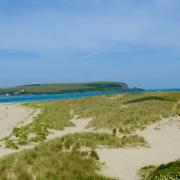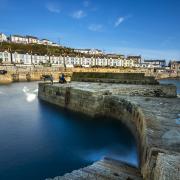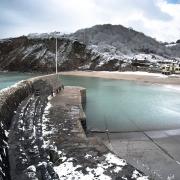It is a town synonymous with mining even by Cornish standards and its all thanks to a man named Trevithick and his little invention which changed the face of the industrial revolution

On the last Saturday in April if you find yourself driving along the main roads of Cornwall, you are likely to see an impressive procession of steam-pressured engines chugging along – loud and proud as they make their way to and from the day-long celebration to mark the achievements of inventor Richard Trevithick.
For those lucky enough to attend, the day includes a procession of seemingly endless steam engines, making their way noisily through the streets. There is live music and a plethora of street performers mingle with shoppers at the many craft stalls and stands selling the best in Cornish produce. The town will be decorated by 3km of bunting courtesy of Camborne BID and there are fairground rides and exhibitions.
And it’s all in recognition of a Cornish genius. Born in 1771, Richard Trevithick (13 April 1771 – 22 April 1833) was the son of a mining captain born in the heyday of Cornish mining. The inventor apparently didn’t do well at school but his high pressure engine was considered a most important invention – although perhaps his enthusiasm for moving onto new inventions meant he wasn’t as successful as he could have been.
A quarter-of-a-century before George Stephenson’s Rocket, Trevithick constructed a railway engine that hauled ten tons of iron and 70 people the 9½ miles to the canal at Abercynon in 1804. “This was the world’s first railway journey and was 25 years before George Stephenson famously won the Rain Hill Trials with his locomotive called ‘Rocket’,” says Philip Hosken, author of ‘Genius, Richard Trevithick’s Steam Engines’ and chairman of the Trevithick Society set up to remember his achievements.
This year marked the first Trevithick Day in Wales to mark the historic journey.
It is for his attempt to travel by steam on Cornwall’s road that he is best remembered in Camborne.
The maiden voyage of Trevithick’s full-size steam road locomotive built in 1801 on a site near Fore Street in the town – successfully carried six passengers up Fore Street and then continuing on up Camborne Hill, from Camborne Cross, to the nearby village of Beacon on Christmas Even 1801 is remembered in the song Goin’ up Camborne Hill. The song – now heard at rugby matches and other Cornish gatherings around the world.
Philip explains: “While Trevithick’s first full sized engines were put to work in Cornish mines, it was still his dream to travel by steam power.
“The first time he achieved this was on Christmas Eve 1801. While his wife was waiting for him to come home to Fore Street in Camborne, he sped by in the rain with his cousin Andrew Vivian and several of his workmen hanging on. They made history that day on what, in the future, would be called ‘Camborne Hill’. Theirs was the world’s first successful journey by a self-propelled vehicle.”
From the late 1790s Trevithick’s invention of a cylindrical boiler that could contain high-pressure steam would change everything.
“His dream was to replace the horse as a form of transport,” continues Philip. “Industrials could see no future in such a contraption but they did see the advantages of Trevithick’s relatively cheap, powerful and efficient little engines to drive the machines in their factories. While they badgered him to produce the engines they required he continued to devise ways to reveal how his little engine could best be used for transport.”
But Trevithick continued with his attempts to create a self-propelled vehicle and decided to try London. “He was years ahead of his time and although he sold tickets the first self-propelled vehicle to run on London’s streets did not attract any buyers so was dismantled and put to industrial use,” adds Philip.
Among his other achievements were dry docks and containerisation. He constructed the first tunnel under the River Thames and supplied engines for silver mines high in the Peruvian Andes. Since his death many myths have grown - among them that he died penniless and was buried in a pauper’s grave and that his original 1801 locomotive exploded.
“There is a special place in the heart of every Cornishman and women for Richard Trevithick,” concludes Philip.
We recommend...
Eating:
The Red River Café
The Red River Café at Heartlands offers light snacks and luscious lunches and tapas nights on the last Friday of the month. It features on the Truly Cornish Cafe Trail which is part of the Choose Cornish campaign so you can be sure of a truly Cornish eating experience!
Shopping:
Treasure Park
A new addition to Camborne’s high street is the great reloved shop, filled with upcycled furniture and accessories.
Head out to nearby Treasure Park home to Cornish Goldsmiths and Cornwall Pearl, there is also a range of fantastic local shops, a café and entertainment for children including panning for tin – and check out the Back to the Future De Lorean and James Bond Astin Martin on display.
treasureparks.comDay’s out:
Heartlands
Head to Heartlands in nearby Pool and find time to take a guided tour (£3) of their engine house to discover more about the workings of these very Cornish landmarks. Find time to wander through their diaspora gardens: which tell the story of plants from Cornwall that found their way all over the world as well as the exotics that were brought back and have become our garden staples. Heartlands also boasts a number of arts studios and galleries exhibiting local artists’ work.
heartlandscornwall.com/things-to-doCornish Mining World Heritage Site
As befitting the heart of the Cornish Mining World Heritage Site, you can also visit Cornish Mines and Engines (NT) at nearby East Pool Mine. Attractions include two great beam engines, originally powered by high-pressure steam boilers introduced by Richard Trevithick.
nationaltrust.org.uk/east-pool-mine/Gwithian Lighthouse
Although a few miles inland, Camborne is only a few minute’s drive to the coast. We recommend Gwithian for some of Cornwall’s best beaches. The National Trust owns Gwithian Lighthouse – which inspired Virgina Woolf’s novel To The Lighthouse. There is also a café there which serves the best hot chocolate in Cornwall, perfect after a bracing walk on Gwithian beach!
Tehidy Country Park
Camborne is the gateway to the largest area of woodland in West Cornwall. Now owned and managed by Cornwall Council as a Country Park, Tehidy has more than nine miles of paths and 250 acres of peaceful woods and lakes to explore, together with a café and a picnic area. An enchanting day out at any time of year.



























